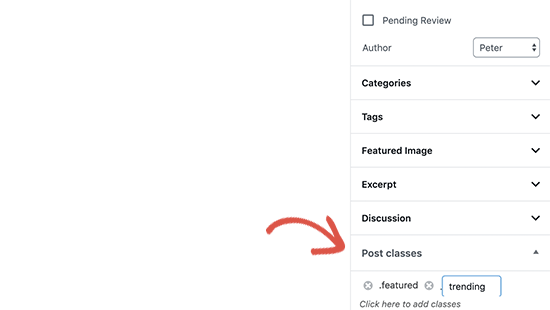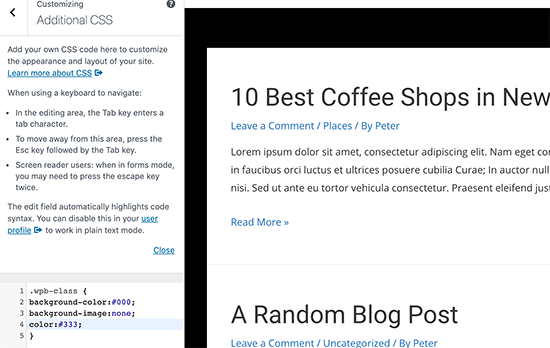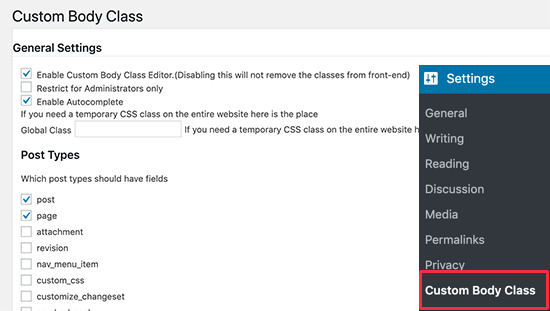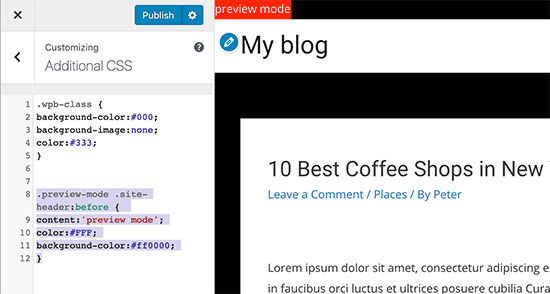Are you an aspiring WordPress theme designer on the lookout for new methods to make use of CSS into your themes?
Fortunately, WordPress automatically adds CSS classes which you can make the most of in your themes. A number of of those CSS courses are mechanically added to the <physique> part of each web page on a WordPress web site.
On this article, we are going to clarify the WordPress physique class with suggestions and tips for aspiring theme designers to make the most of them of their tasks.
Here’s a fast overview of what you’ll study on this article.
- What is WordPress body class?
- When to use the body class
- How to add custom body classes
- How to add body class using a plugin
- Using conditional tags to add custom body classes
- More examples of dynamically adding custom body classes
- Detecting user browser and adding browser specific body class
What’s WordPress Physique Class?
Physique class (body_class) is a WordPress perform that means that you can assign CSS courses to the physique ingredient.
The HTML physique tag usually begins in a theme’s header.php file, which masses on each web page. This lets you dynamically work out which web page a consumer is viewing after which add the CSS courses accordingly.
Usually most starter themes and frameworks already embrace the physique class perform contained in the HTML physique tag. Nevertheless, in case your theme doesn’t have it, then you’ll be able to add it by modifying the physique tag like this:
<physique <?php body_class($class); ?>>
Relying on the kind of web page being displayed, WordPress mechanically provides the suitable courses.
For instance, in case you are on an archive web page, WordPress will mechanically add archive class to the physique ingredient. It does that for nearly each web page.
Associated: See how WordPress works behind the scenes (infographic)
Listed below are some examples of frequent courses that WordPress would possibly add, relying on which web page is being displayed:
.rtl {}
.dwelling {}
.weblog {}
.archive {}
.date {}
.search {}
.paged {}
.attachment {}
.error404 {}
.single postid-(id) {}
.attachmentid-(id) {}
.attachment-(mime-type) {}
.creator {}
.author-(user_nicename) {}
.class {}
.category-(slug) {}
.tag {}
.tag-(slug) {}
.page-parent {}
.page-child parent-pageid-(id) {}
.page-template page-template-(template file identify) {}
.search-results {}
.search-no-results {}
.logged-in {}
.paged-(web page quantity) {}
.single-paged-(web page quantity) {}
.page-paged-(web page quantity) {}
.category-paged-(web page quantity) {}
.tag-paged-(web page quantity) {}
.date-paged-(web page quantity) {}
.author-paged-(web page quantity) {}
.search-paged-(web page quantity) {}
As you’ll be able to see, by having such a strong useful resource at hand, you’ll be able to completely customise your WordPress web page by utilizing simply CSS. You possibly can customise particular author profile pages, date-based archives, and so forth.
That being mentioned, now let’s check out how and when would you utilize the physique class.
When to make use of The WordPress Physique Class
First, you could guarantee that your theme’s physique ingredient accommodates the physique class perform as proven above. If it does, then it can mechanically embrace all of the WordPress generated CSS courses talked about above.
After that, additionally, you will be capable of add your personal customized CSS courses to the physique ingredient. You possibly can add these courses everytime you want them.
For instance, if you wish to change the looks of articles by a selected creator filed beneath a selected class.
Tips on how to Add Customized Physique Courses
WordPress has a filter which you can make the most of so as to add customized physique courses when wanted. We are going to present you easy methods to add a physique class utilizing the filter earlier than displaying you the precise use case state of affairs simply so everybody will be on the identical web page.
As a result of physique courses are theme particular, you would wish so as to add the next code to your theme’s functions.php file.
perform my_class_names($courses) {
// add 'class-name' to the $courses array
$courses[] = 'wpb-class';
// return the $courses array
return $courses;
}
//Now add check class to the filter
add_filter('body_class','my_class_names');
The above code will add a category “wpb-class” to the physique tag on each web page in your web site. That’s not so unhealthy, proper?
Now you’ll be able to make the most of this CSS class in your theme’s stylesheet straight. If you’re working by yourself web site, then you may also add the CSS utilizing the custom CSS feature in theme customizer.
Including Physique Class Utilizing a WordPress Plugin
If you’re not engaged on a consumer venture and don’t need to write code, then this technique could be simpler for you.
The very first thing you could do is set up and activate the Custom Body Class plugin. For extra particulars, see our step-by-step information on how to install a WordPress plugin.
Upon activation, you could go to Settings » Customized Physique Class web page. From right here you’ll be able to configure plugin settings.
You possibly can choose publish varieties the place you need to allow physique class characteristic and who can entry it. Don’t neglect to click on on the save adjustments button to retailer your settings.
Subsequent, you’ll be able to head over to edit any publish or web page in your WordPress site. On the publish edit display, one can find a brand new meta field in the correct column labeled ‘Put up Courses’.

Click on so as to add your customized CSS courses. You possibly can add a number of courses separated by an area.
As soon as you’re performed, you’ll be able to merely save or publish your publish. The plugin will now add your customized CSS courses to the physique class for that individual publish or web page.
Utilizing Conditional Tags with The Physique Class
The actual energy of the body_class perform comes when it’s used with the conditional tags.
These conditional tags are true or false knowledge varieties that verify if a situation is true or false in WordPress. For instance, the conditional tag is_home checks if the web page at present displayed is the homepage or not.
This enables theme builders to verify if a situation is true or false earlier than including a customized CSS class to the body_class perform.
Let’s check out some examples of utilizing conditional tags so as to add customized courses to the physique class.
Let’s say you need to type your homepage in another way for logged in customers with the creator user role. Whereas WordPress mechanically generates a .dwelling and .logged-in class, it doesn’t detect the consumer function or add it as a category.
Now, it is a state of affairs the place you should utilize the conditional tags with some customized code to dynamically add a customized class to the physique class.
To realize this you’ll add the next code to your theme’s features.php file.
perform wpb_loggedin_user_role_class($courses) {
// let's verify whether it is homepage
if ( is_home() ) {
// Now let's verify if the logged in consumer has creator consumer function.
$consumer = wp_get_current_user();
if ( in_array( 'creator', (array) $user->roles ) ) {
//The consumer has the "creator" function
// Add consumer function to the physique class
$courses[] = 'creator';
// Return the courses array
return $courses;
}
} else {
// if it isn't homepage, then simply return default courses
return $courses;
}
}
add_filter('body_class', 'wpb_loggedin_user_role_class');
Now, let’s check out one other helpful instance. This time we’re going to verify if the web page displayed is a preview of a WordPress draft.
To do this we are going to use the conditional tag is_preview after which add our customized CSS class.
perform add_preview_class($courses) {
if ( is_preview() ) {
$courses[] = 'preview-mode';
return $courses;
}
return $courses;
}
add_filter('body_class','add_preview_class');
Now, we are going to add the next CSS to our theme’s stylesheet to make the most of the brand new customized CSS class we simply added.
.preview-mode .site-header:earlier than {
content material:'preview mode';
colour:#FFF;
background-color:#ff0000;
}
That is the way it regarded on our demo web site:
You could need to try the total record of conditional tags that you should utilize in WordPress. This provides you with a helpful set of prepared to make use of tags on your code.
Different Examples of Dynamically Including Customized Physique Courses
Other than conditional tags, you may also use different strategies to fetch data from the WordPress database and create customized CSS courses for the physique class.
Including class names to the physique class of a single publish web page
Let’s say you need to customise the looks of single posts primarily based on the class they’re filed in. You should use the physique class to realize this
First, you could add class names as CSS class on single publish pages. To do this, add the next code to your theme’s features.php file:
// add class nicenames in physique class
perform category_id_class($courses) {
world $publish;
foreach((get_the_category($post->ID)) as $class)
$courses[] = $category->category_nicename;
return $courses;
}
add_filter('body_class', 'category_id_class');
The code above will add the class class in your physique class for single publish pages. You possibly can then use CSS courses to type it as you would like.
Including web page slug to the physique class
Paste the next code in your theme’s features.php file:
//Web page Slug Physique Class
perform add_slug_body_class( $courses ) {
world $publish;
if ( isset( $publish ) ) {
$courses[] = $post->post_type . '-' . $post->post_name;
}
return $courses;
}
add_filter( 'body_class', 'add_slug_body_class' );
Browser Detection and Browser Particular Physique Courses
Typically you might come throughout points the place your theme might have extra CSS for a specific browser.
Now the excellent news is that WordPress mechanically detects browser upon loading after which short-term shops this data as a worldwide variable.
You simply have to verify if WordPress detected a selected browser after which add it as a customized CSS class.
Merely, copy and paste the next code in your theme’s features.php file:
perform wpb_browser_body_class($courses) {
world $is_iphone, $is_chrome, $is_safari, $is_NS4, $is_opera, $is_macIE, $is_winIE, $is_gecko, $is_lynx, $is_IE, $is_edge;
if ($is_iphone) $courses[] ='iphone-safari';
elseif ($is_chrome) $courses[] ='google-chrome';
elseif ($is_safari) $courses[] ='safari';
elseif ($is_NS4) $courses[] ='netscape';
elseif ($is_opera) $courses[] ='opera';
elseif ($is_macIE) $courses[] ='mac-ie';
elseif ($is_winIE) $courses[] ='windows-ie';
elseif ($is_gecko) $courses[] ='firefox';
elseif ($is_lynx) $courses[] ='lynx';
elseif ($is_IE) $courses[] ='internet-explorer';
elseif ($is_edge) $courses[] ='ms-edge';
else $courses[] = 'unknown';
return $courses;
}
add_filter('body_class','wpb_browser_body_class');
You possibly can then use courses like:
.ms-edge .navigation {some merchandise goes right here}
If it’s a small padding or margin problem, then it is a pretty straightforward means of fixing it.
There are undoubtedly many extra situations the place utilizing the body_class perform can prevent from writing prolonged strains of code. For instance, in case you are utilizing a theme framework like Genesis, then you should utilize it so as to add customized courses in your youngster theme.
You should use the body_class perform so as to add CSS courses for full-width page layouts, sidebar content material, header and footers, and so forth.
We hope this text helped you learn to use the WordPress physique class in your themes. You might also need to see our article on how to style each WordPress post differently, and our comparability of best WordPress page builder plugins.
When you favored this text, then please subscribe to our YouTube Channel for WordPress video tutorials. It’s also possible to discover us on Twitter and Facebook.
The publish WordPress Body Class 101: Tips and Tricks for Theme Designers appeared first on WPBeginner.



Leave A Comment
You must be logged in to post a comment.